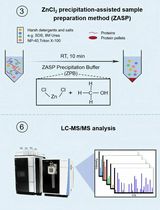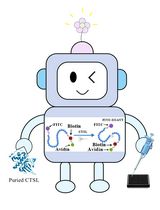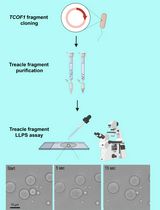- Submit a Protocol
- Receive Our Alerts
- Log in
- /
- Sign up
- My Bio Page
- Edit My Profile
- Change Password
- Log Out
- EN
- EN - English
- CN - 中文
- Protocols
- Articles and Issues
- For Authors
- About
- Become a Reviewer
- EN - English
- CN - 中文
- Home
- Protocols
- Articles and Issues
- For Authors
- About
- Become a Reviewer
Isolation of Chromatin-bound Proteins from Subcellular Fractions for Biochemical Analysis
Published: Vol 8, Iss 19, Oct 5, 2018 DOI: 10.21769/BioProtoc.3035 Views: 20226
Reviewed by: Pabitra Kumar SahooAnna La TorreAnonymous reviewer(s)

Protocol Collections
Comprehensive collections of detailed, peer-reviewed protocols focusing on specific topics
Related protocols

ZnCl2 Precipitation-Assisted Sample Preparation for Proteomic Analysis
Qiqing He [...] Fuchu He
Jul 20, 2025 2625 Views

Fluorescence Polarization-Based High-Throughput Screening Assay for Inhibitors Targeting Cathepsin L
Keyu Guo [...] Shuyi Si
Jul 20, 2025 2177 Views

Protocol for the Preparation of a Recombinant Treacle Fragment for Liquid–Liquid Phase Separation (LLPS) Assays
Nadezhda V. Petrova [...] Artem K. Velichko
Sep 20, 2025 1740 Views
Abstract
Shuttling of proteins between different cellular compartments controls their proteostasis and can contribute in some cases to regulate their activity. Biochemical analysis of chromatin-bound proteins, such as transcription factors, is often difficult because of their low yield and due to the interference from nucleic acids. This protocol describes a method to efficiently fractionate cells combined with a mechanical (i.e., sonication) or an enzymatic treatment (i.e., benzonase) that facilitates analysis of chromatin-bound protein extracts by Western blot analysis or by protein pull-down assays. This approach can be valuable to enrich a particular protein within a particular subcellular fraction either to study specific post-translational modification patterns or to identify specific protein-protein interactions.
Keywords: Chromatin-bound proteinsBackground
The activity and post-translational regulation of many chromatin-bound proteins are poorly studied due to technical difficulties in isolating them for biochemical analysis. This is, even more, the case with transcription factors, such as the basic Helix-loop-Helix (bHLH) transcription factors that often harbor scarce temporal and spatial pattern of expression in tissues or cellular models (Dennis et al., 2018). Protocol refinement helps to lift technical limitation when the amount of biological materials become a barrier to investigate molecular pathways (Gillotin and Guillemot, 2016). In our recent study, we endeavored to understand how proteolysis of the proneural bHLH transcription factor Ascl1 is regulated in cellular models of neuronal differentiation (Gillotin et al., 2018). For this, we adapted existing protocols for subcellular fractionation to obtain efficient separation of the cytoplasm, nuclear and chromatin fractions. To be able to perform biochemical analysis on the chromatin fraction, we either used sonication to shear nucleic acids or treated this fraction with benzonase to degrade nucleic acids. These steps were essential to perform Western blot analysis or protein pull-down assays (Figure 1). This approach successfully led to the analysis of Ascl1 ubiquitylation pattern in the cytoplasm and in the chromatin fractions (Gillotin et al., 2018) and can be extended to the study of other chromatin-bound proteins and to other post-translational modifications.
Figure 1. Workflow of the protocol. First, the collection of each subcellular fraction is performed by successive protein extractions with the buffer E1, then with the buffer E2 and with the buffer E3. Second, the chromatin fraction is either sonicated to shear the DNA or treated with benzonase to digest nucleic acids. Third, each fraction is biochemically analyzed for a protein of interest. The purity of each fraction should be controlled by Western blot for α-Tubulin, LaminB and Histone H3 depicting respectively the cytoplasmic fraction, the nuclear fraction and the chromatin fraction.
Materials and Reagents
Note: All stock solutions should be stored at room temperature except when indicated otherwise.
- Microcentrifuge tubes (Sigma-Aldrich, catalog number: Z336769 )
- 10 cm tissue culture dishes (Thermo Fisher Scientific, NuncTM, catalog number: 150350 )
- Cell scraper (TPP Techno Plastic Products, catalog number: 99002 )
- Pipette tips (STARLAB, TipOne® filter tips, catalog number: S1120 )
- Neural stem cells Cor3-1 (from Steve Pollard, University of Edinburgh)
- P19 cells (ATCC, catalog number: CRL-1825 )
- Protease cocktail inhibitor (Roche Diagnostics, catalog number: 04693116001 )
- 500 mM HEPES-KOH, pH 7.5 prepared from powder (Sigma-Aldrich, catalog number: H3375 )
- 0.5 mM EDTA, pH 8.0 (Sigma-Aldrich, catalog number: 93283 )
- 500 mM EGTA, pH 8.0 prepared from powder (Sigma-Aldrich, catalog number: E3889 )
- 5 M NaCl prepared from powder (Sigma-Aldrich, catalog number: S7653 )
- 1 M MgCl2 prepared from powder (Sigma-Aldrich, catalog number: M8266 )
- 1 M Tris-HCl, pH 8.0 prepared from powder (Sigma-Aldrich, catalog number: RDD008 )
- 1 M Tris-HCl, pH 7.5 prepared from powder (Sigma-Aldrich, catalog number: RDD008 )
- 1 M Tris-HCl, pH 6.8 prepared from powder (Sigma-Aldrich, catalog number: RDD008 )
- 50% Glycerol (Sigma-Aldrich, catalog number: G5516 ) diluted in deionized water
- 10% SDS (Sigma-Aldrich, catalog number: 71736 )
- 10% NP-40 (Sigma-Aldrich, catalog number: I8896 ) diluted in deionized water
- 10% Triton X-100 (Sigma-Aldrich, catalog number: T8787 ) diluted in deionized water
- 100 mM DTT prepared from powder (Sigma-Aldrich, catalog number: 43815 ), store at -20 °C
- PBS (Thermo Fisher Scientific, catalog number: 10010023 )
- Benzonase 10 ku (Merck, Novagen®, catalog number: 70664-3 )
- α-Tubulin antibody (Abcam, catalog number: ab7291 )
- LaminB (Santa Cruz Biotechnology, catalog number: sc-6216 or Gene Tex, catalog number: GTX103292 )
- Histone H3 (Abcam, catalog number: ab1791 )
- E1 Buffer (see Recipes)
- E2 Buffer (see Recipes)
- E3 Buffer (see Recipes)
- E3 (benzonase) Buffer (see Recipes)
Equipment
- Pipettes
- Nanodrop (e.g., Thermo Fisher Scientific, model: NanoDropTM 3300 )
- Water bath sonicator (e.g., Diagenode, model: Bioruptor® )
- Refrigerated centrifuge (e.g., Eppendorf, model: 5415 R )
- Rotating platform (e.g., Grant Instruments, 360° Vertical Multi-function Rotator)
Procedure
Notes:
- As guidance for cell density, neural stem cells Cor3-1 were seeded at 1.5 x 106 in 10 cm dishes and P19 cells were seeded at 1.0 x 106 in 10 cm dishes to reach 70%-80% confluency.
- Before starting, make sure the centrifuge is chilled at 4 °C.
- Wash cells once with room temperature PBS.
- Collect cells with a cell scraper in 1 ml ice-cold PBS and transfer into a 1.5 ml microcentrifuge tube.
- Pellet cells at 130 x g in a refrigerated centrifuge at 4 °C for 3 min.
- Lyse cell pellet with 5 volumes of ice-cold E1 buffer for 1 volume of cell pellet.
- Pipet gently up and down (5 times) before centrifugation at 1,100 x g at 4 °C for 2 min.
- Collect the supernatant in a fresh tube (cytoplasm fraction).
- Resuspend the pellet by gentle pipetting with the same volume of E1 buffer used for the previous step (Step 4).
- Centrifuge immediately at 1,100 x g at 4 °C for 2 min.
- Discard the supernatant and resuspend the pellet by gentle pipetting with the same volume of E1 buffer used for the previous step (Step 4).
- Leave the tube for 10 min on ice.
- Centrifuge at 1,100 x g at 4 °C for 2 min.
- Discard the supernatant.
- Resuspend the pellet by gentle pipetting in 2 volumes of ice-cold E2 buffer for 1 volume of cell pellet.
- Centrifuge at 1,100 x g at 4 °C for 2 min.
- Collect the supernatant in a fresh tube (nucleus fraction).
- Resuspend the pellet with the same volume of E2 buffer used for the previous step (Step 13).
- Centrifuge immediately at 1,100 x g at 4 °C for 2 min.
Note: The pellet should now start to be more difficult to dissolve by pipetting; using wide bore tips might be required. - Resuspend the pellet keeping the same volume of E2 used for the previous step (Step 13).
- Leave the tube for 10 min on ice.
- Centrifuge at 1,100 x g at 4 °C for 2 min.
- Discard the supernatant.
For Western blot analysis:
- Resuspend the pellet by pipetting in ice-cold E3 buffer (same volume as used for E1 in Step 4).
Note: The pellet is very sticky at this stage and precaution should be taken not to lose it. - Sonicate in a water bath sonicator with ice for 5 min, 30 sec ON/30 sec OFF on maximum power (i.e., setting H on Bioruptor).
Note: Ice should be replenished if necessary to keep a constant layer of crushed ice on top of the water bath. - Centrifuge all the fractions (i.e., cytoplasm, nuclear and chromatin) at 16,000 x g at 4 °C for 10 min.
- Transfer each supernatant into fresh microcentrifuge tubes.
- Measure protein concentration (e.g., Pierce BCA Protein Assay kit, Thermo Fisher Scientific, using a NanoDrop) and proceed to Western blot analysis.
Note: The protein concentration of the nuclear fraction might be low, and it could be necessary to precipitate proteins using, for example, Trichloroacetic acid method (see Paredes-Osses and Hardie, 2013).
For pull-down assays:
- Resuspend the pellet in ice-cold E3 (benzonase) buffer (same volume as used for E1 in Step 4).
- Flick the tube to detach the pellet.
- Add benzonase at a 1:1,000 dilution.
- Place the tube on a rotating platform and leave to rotate at 15 rpm for 20 min at room temperature.
Note: Incubation up to 30 min might be required to digest nucleic acids. NP-40 can be replaced with 0.1% SDS to enhance the reaction but the presence of SDS may interfere with downstream applications. - Centrifuge all the fractions at 16,000 x g at 4 °C for 10 min.
- Transfer each supernatant into fresh microcentrifuge tubes.
- Measure protein concentration and proceed to required pull-down assay (e.g., immuno-precipitation or resin pull-down).
Data analysis
Representative data for the efficiency of the cellular fractionation and for ubiquitin pull-down assay are shown in Gillotin et al. (2018) (https://www.nature.com/articles/s41598-018-23056-4.pdf). To assess the efficiency of the cellular fractionation, it is recommended to analyze each fraction by Western blot analysis for α-Tubulin, LaminB and Histone H3 as representative of the cytoplasmic, nuclear and chromatin fractions respectively.
Recipes
Note: Prepare all the solutions fresh from stock solutions before starting and keep on ice. Each solution is complemented with protease inhibitor cocktail and adding specific inhibitors should be considered to study post-translational modifications (e.g., phosphatase inhibitor, DUBs inhibitor).
- E1 buffer
50 mM HEPES-KOH (from 500 mM stock solution, pH 7.5)
140 mM NaCl (from 5 M stock solution)
1 mM EDTA (from 500 mM stock solution, pH 8.0)
10% glycerol (from 50% stock solution)
0.5% NP-40 (from 10% fresh solution)
0.25% Triton X-100 (from 10% fresh solution)
1 mM DTT (from 100 mM stock solution, kept at -20 °C)
Supplemented with 1x protease inhibitor cocktail - E2 buffer
10 mM Tris-HCl (from 1 M stock solution, pH 8.0)
200 mM NaCl (from 5 M stock solution)
1 mM EDTA (from 500 mM stock solution, pH 8.0)
0.5 mM EGTA (from 500 mM stock solution, pH 8.0)
Supplemented with 1x protease inhibitor cocktail - E3 buffer
500 mM Tris-HCl (from 1 M stock solution, pH 6.8)
500 mM NaCl (from 5 M stock solution)
Supplemented with 1x protease inhibitor cocktail - E3 (benzonase) buffer
50 mM Tris-HCl (from 1 M stock solution, pH 7.5)
20 mM NaCl (from 5 M stock solution)
1 mM MgCl2 (from 1 M stock solution)
1% NP-40
Supplemented with 1x protease inhibitor cocktail
Add Benzonase when ready to use (1:1,000 dilution)
Acknowledgments
Illustrations have been modified from the Servier Medical Art service (Les Laboratoires Servier). This work was adapted in Anna Philpott’s laboratory (University of Cambridge) from protocols established in Jason Carroll's laboratory (University of Cambridge). The author is currently supported by funding from the European Union’s Horizon 2020 research and innovation programme under grant agreement No 713140 (The Meso_Brain Project, www.mesobrain.eu).
Competing interests
The author declares no competing interest.
References
- Dennis, D. J., Han, S. and Schuurmans, C. (2018). bHLH transcription factors in neural development, disease, and reprogramming. Brain Res S0006-8993(18)30148-3.
- Gillotin, S., Davies, J. D. and Philpott, A. (2018). Subcellular localisation modulates ubiquitylation and degradation of Ascl1. Sci Rep 8(1): 4625.
- Gillotin, S. and Guillemot, F. (2016). Micro-chromatin immunoprecipation (μChIP) protocol for Real-time PCR analysis of a limited amount of cells. Bio-protocol 6(12): e1846.
- Paredes-Osses, E. and Hardie, K. R. (2013). Cell Fractionation of Pseudomonas aeruginosa. Bio-protocol 3(19): e922.
Article Information
Copyright
© 2018 The Authors; exclusive licensee Bio-protocol LLC.
How to cite
Gillotin, S. (2018). Isolation of Chromatin-bound Proteins from Subcellular Fractions for Biochemical Analysis. Bio-protocol 8(19): e3035. DOI: 10.21769/BioProtoc.3035.
Category
Neuroscience > Cellular mechanisms > Protein isolation
Stem Cell > Pluripotent stem cell > Cell-based analysis
Biochemistry > Protein > Isolation and purification
Do you have any questions about this protocol?
Post your question to gather feedback from the community. We will also invite the authors of this article to respond.
Share
Bluesky
X
Copy link









